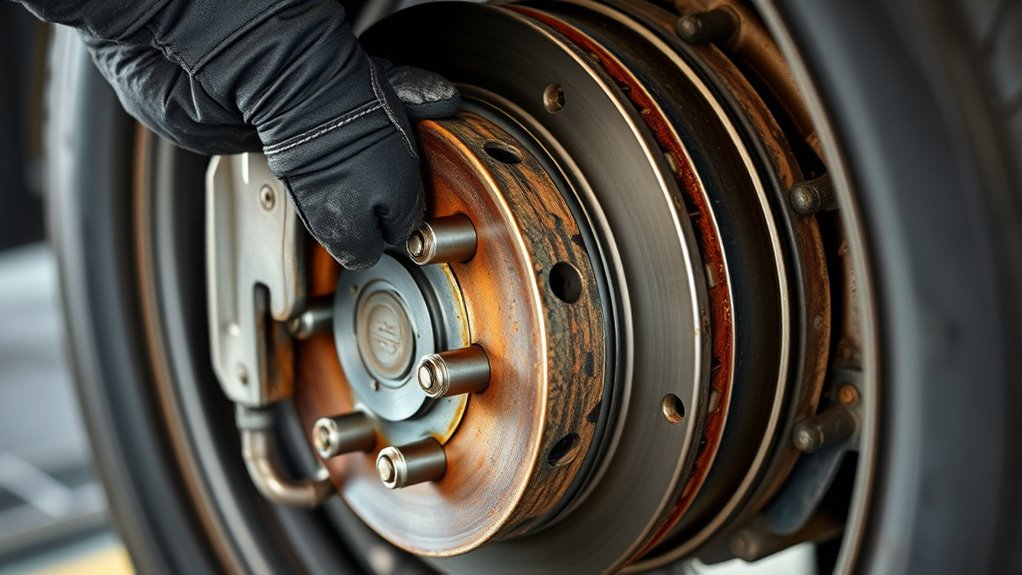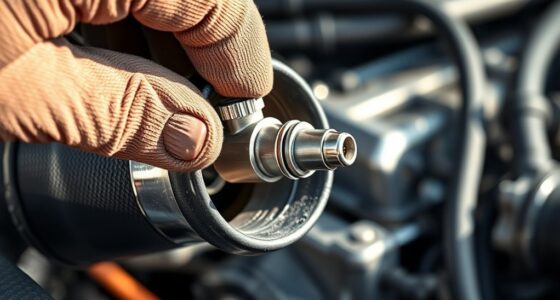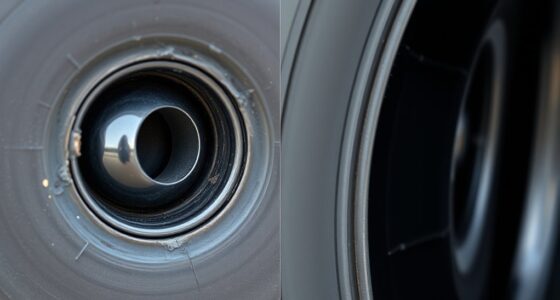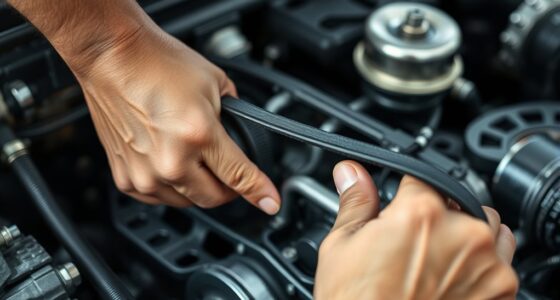Replacing brake pads and rotors involves inspecting the current components for signs of wear like noise, vibration, or reduced stopping power. You’ll need to remove the wheel, caliper, and old parts, then select compatible new rotors and pads—considering materials like ceramic or semi-metallic. Proper installation, including tightening bolts to manufacturer specs, is essential. When done correctly, your brakes will work like new—continue with the next steps to guarantee a safe and effective brake system.
Key Takeaways
- Lift the vehicle, remove the wheel, and inspect the brake components for wear or damage.
- Remove the old brake pads and caliper, then detach and inspect the rotor for cracks, warping, or scoring.
- Choose compatible new rotors and brake pads, then install them correctly, ensuring proper alignment and torque.
- Bed in the new brake pads and rotors through controlled stops to transfer pad material and optimize braking performance.
- Perform a test drive to confirm braking efficiency and listen for any unusual noises, adjusting or seeking professional help if needed.
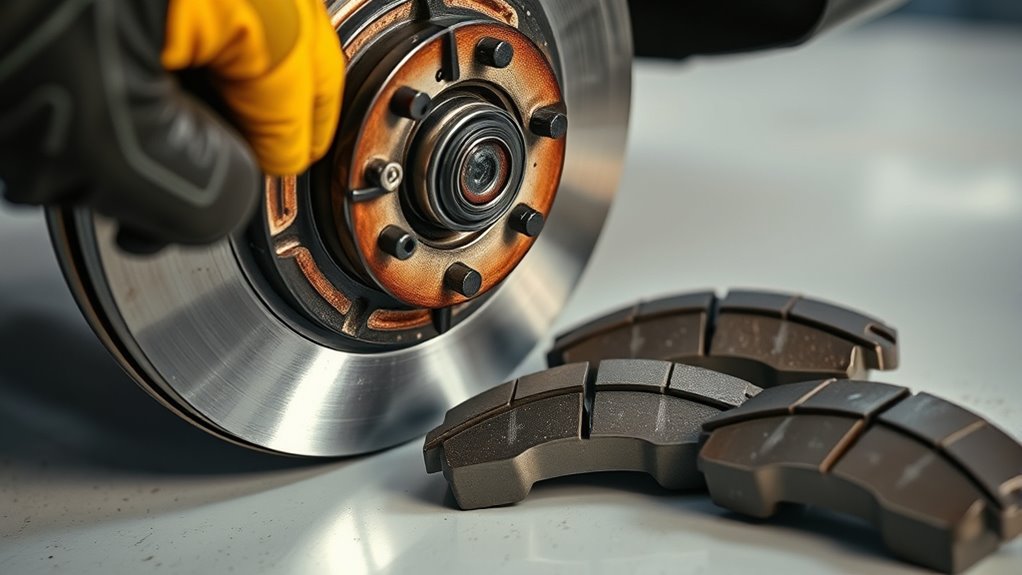
If your vehicle is squeaking, vibrating, or taking longer to stop, it might be time to replace the brake pads and rotors. These components are essential for your safety, and understanding what’s involved can help you prepare for the process. When inspecting your brakes, you’ll notice that the brake pad material plays a significant role in performance. Brake pads come in different materials—organic, semi-metallic, and ceramic—each offering varying levels of durability, heat resistance, and stopping power. Worn-out pads can cause noise, reduced braking efficiency, and uneven wear on the rotors.
Replacing brake pads and rotors involves removing the wheel, caliper, and existing components, then installing new parts. The rotor design is key here. Rotors are made with specific designs—vented, slotted, or drilled—that influence heat dissipation and braking performance. Vented rotors feature internal vents to help cool down quickly, reducing brake fade during heavy use. Slotted and drilled rotors also improve heat dissipation and help expel brake dust and gases, which can otherwise cause brake fade or reduce stopping power. Choosing the right rotor design for your driving habits is vital. For instance, if you frequently tow or drive in hilly terrain, vented or slotted rotors may serve you better.
The process starts with safely lifting your vehicle, removing the wheel, and then taking off the caliper. Once the caliper is out of the way, you’ll remove the old brake pads and inspect the rotor for scores, cracks, or warping. If the rotor surface is uneven or damaged, it might need to be replaced or resurfaced. When installing new rotors, confirm they’re compatible with your vehicle’s specifications and rotor design. Carefully position the new brake pads, making sure they’re correctly aligned with the rotor, and reassemble the caliper. It’s essential to torque all bolts to manufacturer specifications to prevent any issues during braking. Additionally, understanding that proper heat management in brake components enhances performance and safety can help inform your choices during replacement.
Finally, after completing the installation, you’ll need to bed in the new brake pads and rotors. This involves a series of controlled stops to transfer a thin layer of brake pad material onto the rotor surface, guaranteeing peak performance and longevity. Properly replacing your brake pads and rotors not only restores your vehicle’s braking efficiency but also enhances safety. It’s a hands-on task that requires attention to detail, so if you’re unsure, it’s wise to consult a professional. Maintaining your brake system with the right materials and rotor design ensures you’re prepared for any driving situation.
Frequently Asked Questions
How Do I Know When My Brake Pads Need Replacing?
You’ll know your brake pads need replacing when you notice brake warning signs like squealing, grinding noises, or a decrease in braking power. Pay attention to vibrations or a soft brake pedal. Regular maintenance tips include checking the pads’ thickness and listening for unusual sounds during stops. If you experience any of these signs, it’s time to get them inspected and replaced to guarantee safe stopping and avoid further damage.
Can I Replace Brake Pads and Rotors Myself?
Ever wondered if you can tackle brake pad and rotor replacement yourself? While DIY maintenance is tempting, it involves specialized tools and safety precautions. If you’re comfortable working with your vehicle and follow proper instructions, you might give it a shot. However, for most, professional service guarantees safety and proper installation. Do you really want to risk compromising your brakes or missing hidden issues? When in doubt, consult a professional.
How Long Does a Brake Pad and Rotor Replacement Take?
You’ll typically spend about 1 to 2 hours replacing brake pads and rotors. The exact time depends on your experience and tools. During the process, you’ll check the brake pad lifespan and guarantee proper rotor maintenance tips, like cleaning and inspecting for wear. Rushing can cause uneven wear or damage, so take your time to do it right. Proper maintenance helps extend the life of your brakes and keeps you safe.
What Are the Signs of a Failing Brake Rotor?
You’ll notice signs of a failing brake rotor through brake noise like squealing or grinding, and vibration symptoms when you press the brake pedal. If your steering wheel shakes or you feel a pulsating sensation during braking, it’s a clear sign the rotor’s warped or damaged. These issues compromise braking performance, so it’s essential to get your rotors inspected and replaced promptly to guarantee your safety.
How Much Does Brake Pad and Rotor Replacement Typically Cost?
Think of replacing brake pads and rotors as fixing a car’s heartbeat; it’s essential for safety. Typically, the cost estimate ranges from $300 to $800, but pricing factors like vehicle make, parts quality, and labor rates influence this. You might pay less for standard parts or more for premium options. Always get a detailed quote to understand the total cost and guarantee your car’s heart keeps beating smoothly.
Conclusion
Replacing brake pads and rotors may seem intimidating, but with the right tools and a bit of patience, you can handle it yourself. Just remember, it’s not as tough as it looks—you’re really just learning the ropes. Once you get the hang of it, you’ll be back on the road in no time. So don’t throw in the towel; after all, every expert was once a beginner. Your car will thank you for it!
